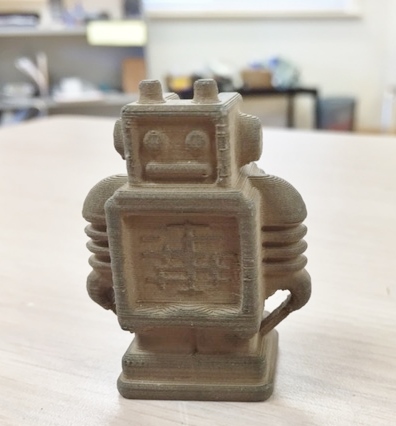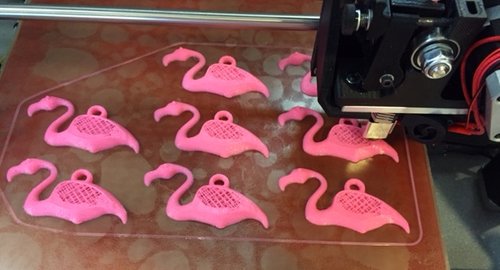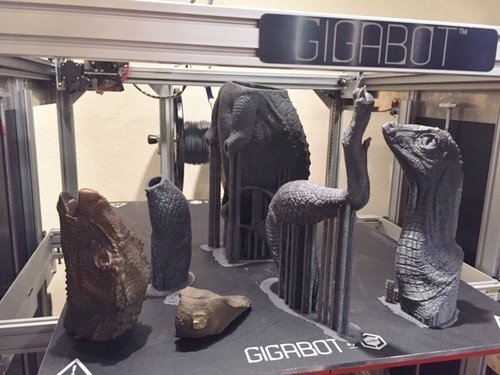by Carolyn Edlund
3D printing technology has the power to transform your art business through innovation in design and productivity.

This metal robot was built by a 3D printer. Designs can quickly be changed and re-made using this technology.
Have you ever considered using 3D printing in designing artwork, or in your studio process? If you’re not familiar with this technology, rest assured that eventually you will be. It is rapidly becoming a mainstream tool for designing and making products of all types. Advancements are moving so quickly that books written just a year or two ago about 3D printing are becoming obsolete.
I had the opportunity to meet with Don Musilli of Englewood Incubation Center for an close-up look at how these printers work, and their applications for artists. I asked him how artists can take advantage of it in their own studios.
“3D modeling software and 3D printers are much easier to use today. They can help translate a two-dimensional object into a three-dimensional object very quickly,” he replied. “This will allow artists to explore whole new areas of creativity. These printers do it quickly and with the ability to make changes in minutes.”

3D Printer technology in use creating multiples of a flamingo design.
He explained the different materials available to be used with 3D printers. “Today, there are 30 to 40 different materials that can be used in the less expensive 3D printers,” he said. “ABS, PLA, HIPS plastics, nylons, bronze, brass, copper, stainless steel, wood, ceramic, magnetic, conductive, carbon fiber, graphene, poly carbonates and other composite materials. Glass is being printed on some special 3D printers.”
This gives artists a huge menu of options for creating original sculpture, maquettes or even materials for use in building large assemblages or installations.
I asked Musilli about the future of this technology and it’s viability for the small studio. He replied that the artist has “the ability to effectively and with a high degree of accuracy. You can scan an object, bring it into 3D modeling software and then modify, change or alter it to your creative needs. Then you can print it out. This allows for rapid modeling and the ability to reproduce objects that otherwise would be difficult or impossible to create before.”
This technology is in wide use in manufacturing of auto and aircraft parts, medical devices, toys, jewelry design, consumer goods of all types and even in the entertainment industry. Because of it’s quick turnaround, versatility and ability to make product on-site, 3D printing saves money and increases design time with lightning speed. As they become more accurate and high-tech, the price of printers is dropping. That makes it practical for artists as they find ways to use this printing in their own work.
Let’s take a look at 3D printer technology in practical studio use. Deep in the Heart Art Foundry of Bastrop, Texas has several printers, used to make models, or even originals of sculptures that will later be cast into bronze. One-of-a-kind sculptures can be made quickly, skipping several steps in the lost wax casting process. For production work, traditional molds would be made of the original.

Dinosaur sculptures are first made on a 3D printer, awaiting the studio process at Deep in the Heart Art Foundry that will cast them in bronze.
The printers do have some drawbacks at this time. Undercuts in the design or very smooth surfaces can require further manual work on the physical object by the artist, but these issues are being addressed as the technology moves forward.
That advancement won’t take long. In the past few years, Musilli says “3D printing has gone from the Wright brothers to rocket science, and improvements are accelerating.”
Want to stay current on cutting edge business articles from Artsy Shark, plus artist features, and an invitation to the next Call for Artists? Click below to sign up for our twice-monthly email. You’ll get all this plus opportunities and special offers that you can’t get anywhere else!


Another great way for artists (especially photographers) to try out 3D printing is by creating lithophanes. I had great success with turning my 2D photographs into 3D printed art. http://blogs.adobe.com/richardcurtis/2014/11/28/creativefriday-sandra-canning-and-3d-printed-photographs/
Thanks for sharing this, Sandra. Great to know there are even more ways artists can take advantage of this incredible technology!